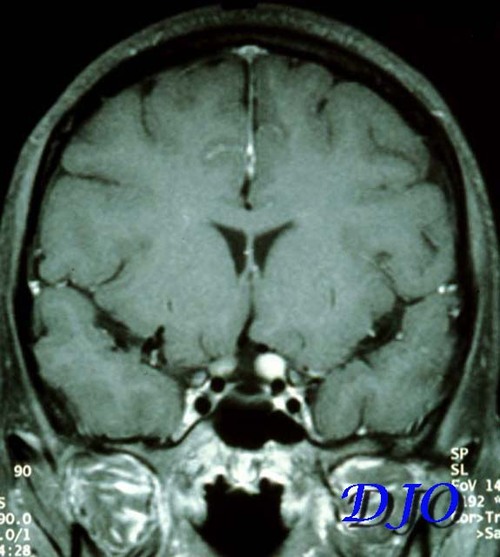|
|
 |
 |
 |
 |
|
|
Neuro-ophthalmology Quiz 6
|
Printer Friendly
|



Howard Pomeranz, M.D., Ph.D | Massachusetts Eye and Ear Infirmary, Harvard Medical School, University of Maryland Medical Center M.A. Afshari, M.D., M.P.H. | Massachusetts Eye and Ear Infirmary, Harvard Medical School August 2, 1997
|
|
[Back to Questions] [Back to Neuro-ophthalmology]
|

Figure 1
Brain MRI (Coronal). MRI scan of the brain revealed enlargement of the left optic nerve and enhancement of the left optic nerve with gadolineum, as illustrated in the coronal section below.
|
| | Case History | A 23 year-old woman complains of "fading in and out " of her vision in the left eye several times a day for two weeks accompanied by mild headache. A CT scan of the head was negative. She was treated with analgesics and acupuncture with improvement in the headaches. The patient subsequently developed pain with eye movement, intermittent numbness and tingling of the left leg and noted gradual worsening of her visual acuity until able to see only "a sliver of vision" in the left eye. The following day she developed complete loss of vision in the left eye. Family history and the patient's medical history were noncontributory.
On examination visual acuity was 16/20 OD and no light perception OS. There was an afferent pupillary defect on the left. The left pupil was sluggishly responsive to consensual light reflex. The exam was otherwise remarkable for a swollen optic nerve on the left. | | | Questions and Answers | 1. What is the diagnosis and what test might be suggested?
Answer: The clinical picture is most consistent with optic neuritis. This diagnosis is suggested by an optic neuropathy accompanied by pain on eye movement, a central scotoma, dyschromatopsia, red desaturation and loss of contrast sensitivity in a young patient. The optic nerve can be normal or edematous in appearance. An MRI scan of the brain and anterior visual pathway is helpful in determining the possible etiologies for optic neuritis. The most common etiology would be multiple sclerosis. Others would include lupus and sarcoidosis.
2. What treatment options could be presented to the patient?
Answer: The Optic Neuritis Treatment Trial supports either observation or the use of intravenous corticosteroids.
| | | [Back to Questions] |
|
 |
 |
 |

|
|
 Welcome, please sign in
Welcome, please sign in  Welcome, please sign in
Welcome, please sign in